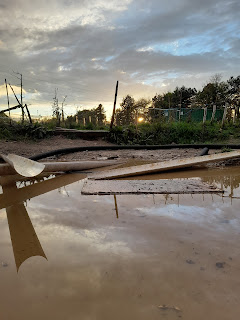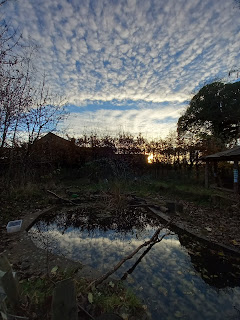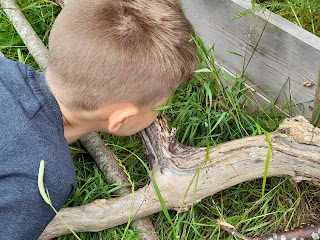MUD!
Looking back over Forest School from September 2019 surprisingly few sessions have been in a downpour. That's not to say that plenty were not wet - they certainly were! - but either it was lighter rain, or wet from overnight rain, or somehow scattered showers missed our session time, or, as we all know, it waited till 3pm to start!
Inuit languages/dialects have 40 - 50 words for 'snow'. It saves having to describe it with a sentence. For instance, snow that has fallen and is on the ground is aput, while piqsirpoq is snow that is drifting across the land rather than qimuqsuq which is an actual snowdrift.
In Kent this week we've used many words for rain! It pounded, and poured, hammered and pelted, drenched and flooded much of the county. A lot of it has been overnight, but days have not been unscathed! Forest School this week was at its driest times - damp!
This was accompanied by high winds for part of the week, with gusts verging on safety levels for us, and impeding what activities and resources we could have out, as chasing spotter sheets around is limited fun, as are soggy books!
However, all pupils love a bit of rain... why?
Because Rain = MUD!
 Forest School needs to take a leaf out of the Inuit vocabulary book and find 50 words for mud!
Forest School needs to take a leaf out of the Inuit vocabulary book and find 50 words for mud!
Word for:
Mud Puddles
Mud Water
Mud Soup
Mud Paint
Mud Blancmange
Mud Pie
Mud Flubber
Mud Putty
Mud Clay
Mud Mortar
Mud Plaster
Mud Burgers
Mud with chalk
Mud with gravel
Mud with grass
and when it dries:
Mud Powder
Mud Frisbees
Mud Mounds
We use mud for building, for decoration, for art, for glue, for paint...
The children make sculptures, pictures, cakes, stews, and to hold bricks, rocks, and sticks in place.
Children learn by trial and error how to get the perfect consistency for the use they have in mind. Whether they need to add dry soil or more liquid to the concoction to get it fit for purpose takes persistence and repetition. They work alone or together. They chat, advise, share information and encourage each other. They experiment, plan, trial, alter, estimate, measure, test, mix, knead, roll, and smear. They imagine and plan and design, develop ideas, troubleshoot, and problem-solve. They cooperate, communicate, collaborate, celebrate and SMILE!
Mud is a free and almost endless resource, and it's a versatile, effective, and powerful one. We don't limit how much they can have, or how they use it. The children can create and utilise it in any way they imagine!
Mud is pure alchemy! Finding the consistency required is a feat of chemistry and engineering in itself!
There are provisos.
Mud play is generally safe, but standing water needs to be monitored because it can carry eggs, larvae, germs, bacteria, urine, and hidden feces - and puddles are the usual source of water for mud!
But if it's from fresh rainfall, or if you know the water at hand typically disperses within 24 hours and is therefore relatively 'new', and if you ensure it is in your safety sweep and Risk Assessment, it ought to be OK to use.
Try to ensure mud doesn't get into eyes, ears, mouth, or nose - remove it if it does! And the very obvious - wash hands very thoroughly when finished!
There are studies that suggest that childhood exposure to microbes and bacteria can help build immunity in children. Children brought up on farms and using the natural outdoors as a playground are less likely to develop allergies and asthma!
Mud does mean getting wet. Maybe just fingers and hands, but often from head to toe! In the Summer, body surfing along the mud into damp grass will test even the best waterproof clothing - if they are even being worn in 25 degrees of heat! In Autumn, Winter, and Spring it can mean being very uncomfortable for quite a long period of time, and I don't have a foolproof solution for this. The best we can advise is warm layers of clothing with a waterproof outer layer, plus something warm to change into afterward. We encourage the children to keep moving when cold and discuss how this changes their heartbeat and temperature. If they understand how this makes them feel, then they can begin to take some responsibility for keeping themselves warm.
Of course, some days, finishing the session early, having hot drinks, moving inside for a story, etc are all options that we have available and will be used to fit the specific circumstances of the session.
Mud transferring into the school building is a logistic we have yet to perfect. Footwear off at the door is the first rule. But muddy clothes often drip and washing hands either leaves the bathroom looking like WWI trenches or hand prints in the classroom... to change BEFORE the bathroom or AFTER is the eternal question! As is how long does it take to get 30 children who look like extras from Apocolypse Now to wash their hands at 3 sinks...?
Our Cleaners deserve medals!
So why do we do it to the washing machines of Kent?
If I say because it makes the children happy would that be enough? Not just their wellbeing, but the release of serotonin that comes with joyful playing in mud has been shown to improve cognitive function. It boosts mental health AND can make you smarter! While allowing children to connect and interact with their environment, nature, and the world around them, it provides fresh air, sunlight, rain, wind, exercise for fine motor skills and gross motor skills AND gets them away from screens!
It boosts creativity, critical thinking, constructive ideas, imagination, and teamwork - skills needed in the classroom, in education, and in life.
And it is wonderfully tactile!
Mud Monsters are confident. They smile a lot. They bond well with other mud monsters.
And as for the full body experience...
The developing human vestibular system is challenged by movement in all directions, slipping & sliding and even rolling down slopes doesn't just engage core muscles and gross motor skills! It helps to provide the necessary stimulation to the muscles and ligaments in the body to improve the sense of coordination and awareness of our body's position at any given time (the proprioceptive sense), and this is exactly what children need to develop properly!
Meet you in the dig pit!



.jpg)









Comments
Post a Comment